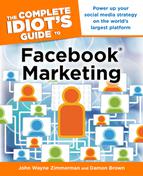Alternatives That Work
Minisites are cool, but you don’t have to hire a programmer or reinvent the Facebook template to make a sale.
If you have already developed your main website and are happy with its sales process, you can simply use Facebook to link to your primary company site.
Alternatively, if you’d like to drive more traffic to your Facebook page, you can link from your company website to Facebook.
The best way to connect your Facebook page to your company website and vice versa is by using the Facebook API, or application programming interface.
| DEFINITION |
API stands for application programming interface. It is code that creates faster communication between different software programs. Well-written APIs enable you to access a software’s power without having to get your hands too dirty with all the technical stuff.
The API is a collection of programming shorthands that make it easier for Facebook to communicate with other websites, including your own. The Facebook API has been available for years, but in 2010 the programming suite got a major overhaul and was renamed Open Graph.
On April 21, 2010, Facebook CEO Mark Zuckerberg hopped on stage at his F8 Developers Conference and let everyone know that his website wanted to organize the internet. Why can’t you link your Facebook stats, for instance, to your Yelp or Tumblr statistics? He argued that the only true way to understand web patterns was to have one unifying set of data. The new Facebook API Open Graph would do just that.
| DEFINITION |
Open Graph is a Facebook application that enables users to interact with the rest of the internet.
Using Open Graph, you can use Facebook logins and data without having to ask your customer to input any info themselves or having to create and store your own database. It’s like using Facebook’s power without having to set foot in Facebook. Open Graph streamlines the connection between your site and Facebook virtually automatically. Drop Open Graph into your website and it does the following takes:
• It recognizes if your visitor is a Facebook user.
• If your visitor is a Facebook user, it automatically checks to see if he or she is logged in.
• If logged in, the user can comment on your blog under his or her Facebook name.
| FEEDBACK |
Open Graph isn’t limited to websites. In fact, many mobile apps use Open Graph to get user information. By using Open Graph, their customers can dive right into the app. It also makes it easy for the app to post news onto users’ Walls—ideally with their permission!
To install Open Graph, you need to have a little HTML know-how. Facebook provides a few lines of code that you plug in to your website HTML. After you plug in the code, the Like button displays on your website and, when a user clicks on it, “So-and-so likes your company” displays in his Facebook Wall.
Open Graph provides a great way to get more exposure for your company, product, or service. Let’s say you are a record company releasing a new single from an artist. You can install Like buttons on the artist’s personal website, the company’s corporate website, the websites of the company’s other artists, and so on. Each Like appears on the user’s Wall, which will make the user’s friends curious about the artist.
| WATCH OUT |
When you click on the Like button on any website where the Facebook Like is installed, Facebook posts your Like to all of your friends on your Wall and, depending on the Like programming the page used, it could post your picture and your name on their Facebook feed. If you’re concerned about this privacy issue, be careful what you Like.
Facebook Credits
Facebook Credits are the website’s secure way of doing transactions (see Figure 17.3). They are most often used for virtual goods.

Figure 17.3: Learning about Facebook Credits.
Let’s say your friend is having a birthday and you’d like to put a teddy bear on her Facebook Wall. Certain apps will enable you to put virtual gifts on her Wall for anywhere from $1 to several dollars.
These transactions were initially done by credit card, but Facebook Credits now lets customers make secure purchases with one click.
Your business can still use credit cards, too, but there are a few solid reasons to use Facebook Credits instead:
• Your customer likely already has his or her credit card info or PayPal account stored within Facebook Credits.
• Facebook Credit gift cards can be purchased at physical stores like Wal-Mart and Target.
• Customers are more likely to spend more “abstract” Facebook Credits than traditional credit card currency.
Like Open Graph, setting up Facebook Credits requires knowledge of HTML/JavaScript.
This is one of those cases where it’s worth the money to outsource these details instead of handing them yourself. However, if you’re feeling adventurous or would like to steer your hired programmer in the right direction, you can visit https://developers.facebook.com/credits/ for several pages of code you can copy and paste into your Facebook website.
The Least You Need to Know
• People come to Facebook to interact, so to generate a sale you first need to engage with your users.
• It might be useful to think of your Facebook page as a minisite of your main company website.
• A custom Facebook page requires some programming that you can outsource.
• Open Graph enables Facebook users to Like your product or website outside of Facebook.
• Facebook Credits are a safe, secure way for customers to spend money on your business within the Facebook website.
